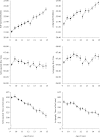The increase in longitudinally measured sleepiness across adolescence is related to the maturational decline in low-frequency EEG power
- PMID: 18246977
- PMCID: PMC2276129
- DOI: 10.1093/sleep/30.12.1677
The increase in longitudinally measured sleepiness across adolescence is related to the maturational decline in low-frequency EEG power
Abstract
Objectives: A changing sleep schedule that reduces sleep duration is thought to produce the increasing daytime sleepiness of adolescents. We tested the hypothesis that adolescent daytime sleepiness also results from adolescent brain maturational processes indexed by declining delta electroencephalographic (EEG) activity.
Design: Data are from the first 3 years of a semilongitudinal study of EEG changes in adolescence. All-night EEG was recorded semiannually.
Setting: EEG was recorded with ambulatory recorders in the subjects' homes.
Participants: Thirty-one subjects were 9 years old (cohort C9), and 38 subjects were 12 years old (cohort C12) at the start of the study.
Measurements: EEG power density (power/minute) was calculated for the first 5 hours of non-rapid eye movement sleep. Subjects rated sleepiness on a modified Epworth Sleepiness Scale. Habitual sleep schedules were assessed with self-reports and actigraphy.
Results: In C9 subjects, sleepiness increased slightly and was related only to age. In C12 subjects, the increase in subjective sleepiness was related to changes in age, bedtime, time in bed, and a wide frequency range of EEG power density. Sleepiness was not related to rise time, non-rapid eye movement sleep duration, rapid eye movement sleep duration, or total sleep time. With sleep schedule measures statistically controlled, the increase in sleepiness in the C12 group was strongly related to declining delta power density and, unexpectedly, even more strongly related to declining theta power density.
Conclusions: The data support our hypothesis that, independent of sleep schedule changes, increasing adolescent daytime sleepiness is related to brain maturational changes indexed by declining EEG power. Our working hypothesis is that the declines in delta and theta power are correlates of an adolescent synaptic pruning that reduces waking arousal levels.
Figures




Similar articles
-
Topographic differences in the adolescent maturation of the slow wave EEG during NREM sleep.Sleep. 2011 Mar 1;34(3):325-33. doi: 10.1093/sleep/34.3.325. Sleep. 2011. PMID: 21358849 Free PMC article.
-
Slow eye movements and subjective estimates of sleepiness predict EEG power changes during sleep deprivation.Sleep. 2007 May;30(5):610-6. doi: 10.1093/sleep/30.5.610. Sleep. 2007. PMID: 17552376
-
Association between pupillary unrest index and waking electroencephalogram activity in sleep-deprived healthy adults.Sleep Med. 2013 Sep;14(9):902-12. doi: 10.1016/j.sleep.2013.02.003. Epub 2013 Jun 14. Sleep Med. 2013. PMID: 23770159 Clinical Trial.
-
Sleep EEG changes during adolescence: an index of a fundamental brain reorganization.Brain Cogn. 2010 Feb;72(1):56-65. doi: 10.1016/j.bandc.2009.09.008. Epub 2009 Nov 2. Brain Cogn. 2010. PMID: 19883968 Review.
-
Delta wave power: an independent sleep phenotype or epiphenomenon?J Clin Sleep Med. 2011 Oct 15;7(5 Suppl):S16-8. doi: 10.5664/JCSM.1346. J Clin Sleep Med. 2011. PMID: 22003323 Free PMC article. Review.
Cited by
-
Sleep and the transition to adolescence: a longitudinal study.Sleep. 2009 Dec;32(12):1602-9. doi: 10.1093/sleep/32.12.1602. Sleep. 2009. PMID: 20041596 Free PMC article.
-
Differential and interacting effects of age and sleep restriction on daytime sleepiness and vigilance in adolescence: a longitudinal study.Sleep. 2018 Dec 1;41(12):zsy177. doi: 10.1093/sleep/zsy177. Sleep. 2018. PMID: 30169721 Free PMC article.
-
Chronic intermittent ethanol during adolescence and adulthood alters dendritic spines in the primary motor and visual cortex in rats.Alcohol. 2021 Dec;97:67-74. doi: 10.1016/j.alcohol.2021.09.032. Epub 2021 Oct 7. Alcohol. 2021. PMID: 34626787 Free PMC article.
-
Assessing narcolepsy with cataplexy in children and adolescents: development of a cataplexy diary and the ESS-CHAD.Nat Sci Sleep. 2017 Aug 14;9:201-211. doi: 10.2147/NSS.S140143. eCollection 2017. Nat Sci Sleep. 2017. PMID: 28860883 Free PMC article.
-
Daily rhythms of the sleep-wake cycle.J Physiol Anthropol. 2012 Mar 13;31(1):5. doi: 10.1186/1880-6805-31-5. J Physiol Anthropol. 2012. PMID: 22738268 Free PMC article. Review.
References
-
- Carskadon MA, Wolfson AR, Acebo C, Tzischinsky O, Seifer R. Adolescent sleep patterns, circadian timing, and sleepiness at a transition to early school days. Sleep. 1998;21:871–881. - PubMed
-
- Gau SF, Soong WT. Sleep problems of junior high school students in Taipei. Sleep. 1995;18:667–73. - PubMed
-
- Iglowstein I, Jenni OG, Molinari L, Largo RH. Sleep duration from infancy to adolescence: Reference Values and generational Trends. Pediatrics. 2003;111(2):302–307. - PubMed
-
- Laberge L, Petit D, Simard C, Vitaro F, Tremblay RE, Montplaisir J. Development of sleep patterns in early adolescence. J Sleep Res. 2001;10:59–67. - PubMed
Publication types
MeSH terms
Grants and funding
LinkOut - more resources
Full Text Sources
Research Materials
Miscellaneous

